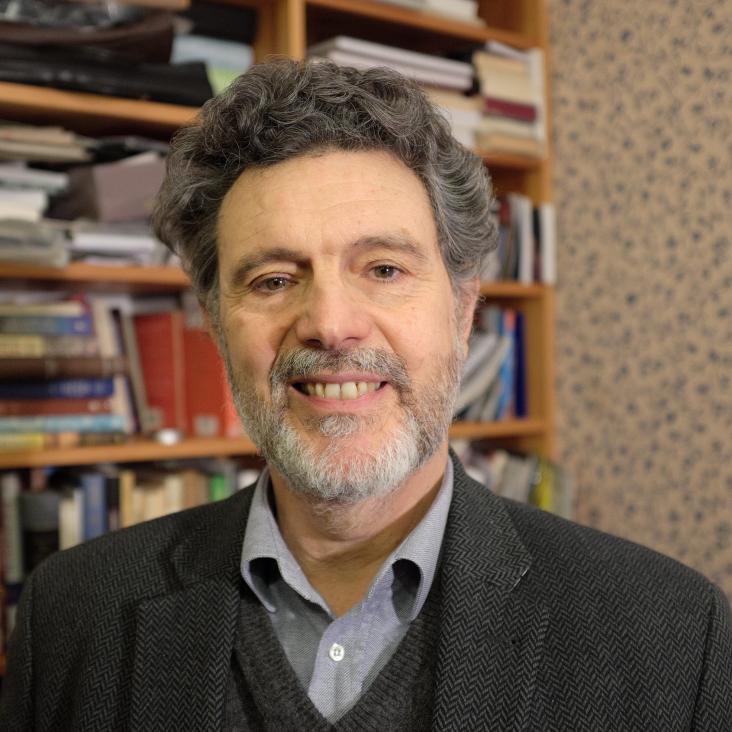Reversible hydrogen control of antiferromagnetic anisotropy in α-Fe2O3
Nature Communications Springer Nature 12:1 (2021) 1668
Crystallographic, optical, and electronic properties of the Cs2AgBi1-xInxBr6 double perovskite: understanding the fundamental photovoltaic efficiency challenges
ACS Energy Letters American Chemical Society 6:3 (2021) 1073-1081
Abstract:
We present a crystallographic and optoelectronic study of the double perovskite Cs2AgBi1–xInxBr6. From structural characterization we determine that the indium cation shrinks the lattice and shifts the cubic-to-tetragonal phase transition point to lower temperatures. The absorption onset is shifted to shorter wavelengths upon increasing the indium content, leading to wider band gaps, which we rationalize through first-principles band structure calculations. Despite the unfavorable band gap shift, we observe an enhancement in the steady-state photoluminescence intensity, and n-i-p photovoltaic devices present short-circuit current greater than that of neat Cs2AgBiBr6 devices. In order to evaluate the prospects of this material as a solar absorber, we combine accurate absorption measurements with thermodynamic modeling and identify the fundamental limitations of this system. Provided radiative efficiency can be increased and the choice of charge extraction layers are specifically improved, this material could prove to be a useful wide band gap solar absorber.Antiferromagnetic half-skyrmions and bimerons at room temperature
Nature Springer Nature 590:7844 (2021) 74-79
Abstract:
In the quest for post-CMOS (complementary metal–oxide–semiconductor) technologies, driven by the need for improved efficiency and performance, topologically protected ferromagnetic ‘whirls’ such as skyrmions1,2,3,4,5,6,7,8 and their anti-particles have shown great promise as solitonic information carriers in racetrack memory-in-logic or neuromorphic devices1,9,10,11. However, the presence of dipolar fields in ferromagnets, which restricts the formation of ultrasmall topological textures3,6,8,9,12, and the deleterious skyrmion Hall effect, when skyrmions are driven by spin torques9,10,12, have thus far inhibited their practical implementation. Antiferromagnetic analogues, which are predicted to demonstrate relativistic dynamics, fast deflection-free motion and size scaling, have recently become the subject of intense focus9,13,14,15,16,17,18,19, but they have yet to be experimentally demonstrated in natural antiferromagnetic systems. Here we realize a family of topological antiferromagnetic spin textures in α-Fe2O3—an Earth-abundant oxide insulator—capped with a platinum overlayer. By exploiting a first-order analogue of the Kibble–Zurek mechanism20,21, we stabilize exotic merons and antimerons (half-skyrmions)8 and their pairs (bimerons)16,22, which can be erased by magnetic fields and regenerated by temperature cycling. These structures have characteristic sizes of the order of 100 nanometres and can be chemically controlled via precise tuning of the exchange and anisotropy, with pathways through which further scaling may be achieved. Driven by current-based spin torques from the heavy-metal overlayer, some of these antiferromagnetic textures could emerge as prime candidates for low-energy antiferromagnetic spintronics at room temperature1,9,10,11,23.Halide segregation in mixed-halide perovskites: influence of A-site cations
ACS Energy Letters American Chemical Society 6:2 (2021) 799-808
Abstract:
Mixed-halide perovskites offer bandgap tunability essential for multijunction solar cells; however, a detrimental halide segregation under light is often observed. Here we combine simultaneous in situ photoluminescence and X-ray diffraction measurements to demonstrate clear differences in compositional and optoelectronic changes associated with halide segregation in MAPb(Br0.5I0.5)3 and FA0.83Cs0.17Pb(Br0.4I0.6)3 films. We report evidence for low-barrier ionic pathways in MAPb(Br0.5I0.5)3, which allow for the rearrangement of halide ions in localized volumes of perovskite without significant compositional changes to the bulk material. In contrast, FA0.83Cs0.17Pb(Br0.4I0.6)3 lacks such low-barrier ionic pathways and is, consequently, more stable against halide segregation. However, under prolonged illumination, it exhibits a considerable ionic rearrangement throughout the bulk material, which may be triggered by an initial demixing of A-site cations, altering the composition of the bulk perovskite and reducing its stability against halide segregation. Our work elucidates links between composition, ionic pathways, and halide segregation, and it facilitates the future engineering of phase-stable mixed-halide perovskites.Antiferromagnetic half-skyrmions and bimerons at room temperature
University of Oxford (2021)



